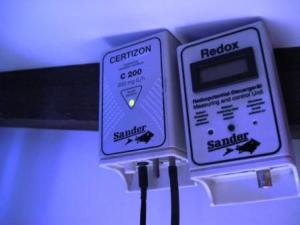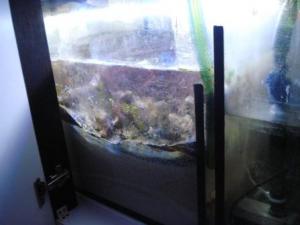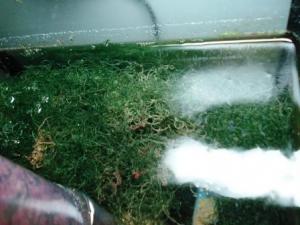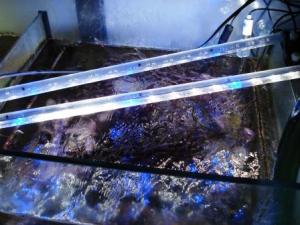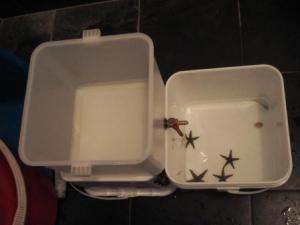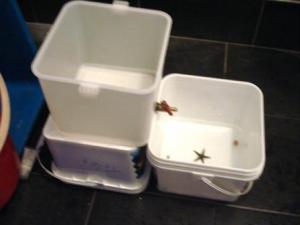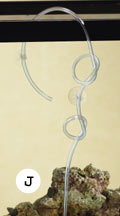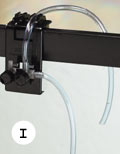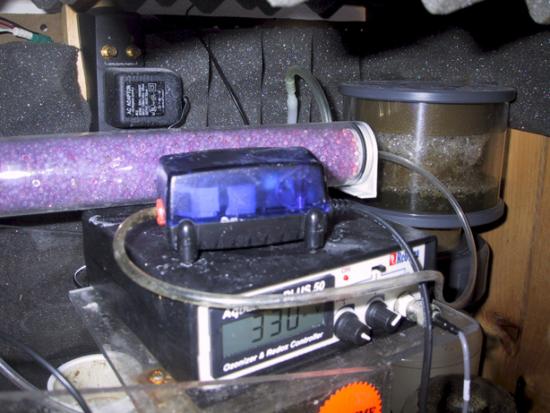-
Posts
8,253 -
Joined
-
Last visited
-
Days Won
31
Content Type
Profiles
Forums
Gallery
Everything posted by Harlequinmania
-
-
-
Not all angel is reef safe, you can either consider getting a " proven reef safe" angel fish from fellow reefer or keep your finger cross.. But so far so good for my tank, and if one of the angel started nipping on my LPS, i will shift the LPS to another location and it does help to stop them nipping the same coral again..
-
These are normal sun corals, just try to place it in places of low light, high flow and feed it regularly and it will open everyday with a smile. However, target feed is recommanded in order to keep it healthy in the long run.
-

Step by Step guide to Fish Acclimation
Harlequinmania replied to Harlequinmania's topic in New to the Marine Aquaria Hobby
Acclimation of clams / sponges Sponges, clams, scallops, and gorgonias should never be directly exposed to air. Follow the acclimation procedure, but instead of netting the specimen out of the shipping bag, submerge the bag underwater in the aquarium and remove the marine life from the bag. Seal off the shipping bag underwater by twisting the opening, and remove it from the aquarium. Discard both the shipping bag and the enclosed water. A tiny amount of the diluted shipping water will escape into the aquarium. Do not be alarmed; this will have no adverse effect on the tank inhabitants. ** Extracted from pet eduction.com ** -

Step by Step guide to Fish Acclimation
Harlequinmania replied to Harlequinmania's topic in New to the Marine Aquaria Hobby
Turkey Baster Method Pros This method is also gentle, safe and easy way to introduce your new saltwater fish to your home aquarium and takes less than an hour to complete. The bag water will be eventually replaced by your own saltwater. This method also provides re-oxygenation of the saltwater in the bag and slowly introduces the fish to your saltwater aquarium’s level of pH and other water chemistries. No nets, scoops or other stress inducing methods are used avoiding acclimation shock and any other stressful situation for the fish. Fish are individually confined if you have more than one you are trying to introduce to your saltwater aquarium. You can use this method not only for saltwater fish acclimation but also for all types of marine livestocks. Cons This method may make you acclimating your fish too fast and not allowing enough time for proper acclimation of your live stocks. Instruction Open the bag and lower it into your saltwater aquarium. Secure to the top with any devise that can hold it still. Turn off all aquarium lighting if possible to prevent less stress to the fish if possible. Let the water temperature from the bag stabilize with the temperature of your saltwater. Using a large new plastic turkey baster that has no metal parts, add 1 or 2 full squeeze bulbs of your tank water to the bag and wait for about 10 minutes. Remove 3 bulbs of water from the bag and throw it away. Add 2 more bulbs of your tank water and wait for another 10 minutes. Repeat 4 and 5 until the recycling of bag water is complete. Submerge the entire bag under water and let your new saltwater fish swim out. -

Step by Step guide to Fish Acclimation
Harlequinmania replied to Harlequinmania's topic in New to the Marine Aquaria Hobby
Dripping Method Pros This method is gentle, safe and easy way to introduce your new saltwater fish to your home aquarium. Once the drip line is started and the flow rate is set, it pretty much takes care of itself. You can use this method not only for saltwater fish acclimation but also for all types of marine livestocks. Cons It can take up to two hours for this method to be completed depending on the size of size of the acclimation container being used. There is a lot of set up involved. If you are acclimating more than one saltwater fish, this means you have to either use a separate acclimation container for each one or put them all together in the same one. If you combine the fish, they may fight and injure each other even before you can get them into your aquarium, especially if they are of the same or similar species. This method may have you move too fast and not allow enough time for proper acclimation process. Instruction Put the fish in any container of enough size to be covered Set the bucket on the floor close to the aquarium you’ll be putting the fish into when done. Using some plastic air line tubing and an air gang value, set up and run a siphon drip line from the aquarium you will be placing the fish into, to the bucket. ( Or you can also use a container drip of your tank water to the container ) Siphon and drip as slowly as possible the tank water into the container using the gang air valve to adjust the drip rate. Do not set the water drip rate too fast nor too slow. Set it in between. Maybe 1 drop per sec. If you are acclimating several fish bought from different LFS, it’s the best way to do it individually in a container of their own since each LFS water paremeter is different. When the water in the container equals to about two to three times the volume of the bag water, pour half or 2/3 of the water in the container and repeat step 3 to continue dripping the water again until the water in the container double it's voume again. Swicth off all aquarium for at least 2 hour before and after introuction of the new fish to the tank. Gently remove the fish from the container and place it into your aquarium . -

Step by Step guide to Fish Acclimation
Harlequinmania replied to Harlequinmania's topic in New to the Marine Aquaria Hobby
Measuring cup method of Fish acclimation Pros This method is a gentle, safe and easy way to introduce your new saltwater fish to your home aquarium, and usually takes less than an hour to complete. This method provides re-oxygenation of the saltwater in the bag and slowly introduces the fish to your saltwater aquarium’s level of pH and other water chemistries. You can use this method not only for saltwater fish acclimation but also for all other types of marine livestocks. Cons This method may cause you to acclimate the fish too fast and having not enough time for proper saltwater fish to stabilize itseld in the new environment. Instructions Open the bag. If full of packing water, pour about half of it and discard. Cut or fold the top of the bag if there’s any excess. SWitch off all your aquarium light , to reduce any stress to the fish introduction to it's new environment. Place the bag inside your saltwater aquarium and secure to the top with any devise that can hold it still making sure that no water from the bag gets into the aquarium or vice versa. This will help to stabilize the temperature of the water in the bag with the water in your tank. Drop airstone into the bag for a couple of minutes to help with re-oxygenation. ( Optional ) Scoop out about 1/4 cup of you aquarium saltwater and pour it into the bag and wait 10 minutes. Repeat this process until the water in the bag is full. Remove half or 2/3 of the water in the bag and repeat process 6 above again until the bag is full. Gently hand scoop, use a soft mesh net (you can usually get this from your local fish store), or use a small perforated container to lift the fish out of the bag and put it in your aquarium trying not to stress the fish too much. Discard the water in the bag and never pour it into your tank as it might contain dieases which will affect your whole tank ! It should be swimming happy after a day or two . -
As you said, both are expensive and territorial fish and i wouldnt try it if i will you .. Prehapes a larger tank with plenty of space to swim and place for the either fish to hides will be a good try.
-
Putting function before form, members of the Perissodinus genus of fish have developed a hugely lopsided jaw that provides a distinct feeding advantage. Researchers describe how these scale-eating fish, called cichlids, develop mouths directed either to the left or the right -- enabling them to feed on the opposite side of their prey. View the full article
-
A good pointer, and i guess this is not happening in all other forum but in the e-bay as well . If you observed in the e-bay where they started their prices really low and when you bid , someone will outbid you to try to make you bid higher ect.. Maybe i will includes these into the "Read this before you post" under the pasa malam section as well Yes, newbie should do be more curious about bidding as the value of the products may not be a good deal and it is adviceable to also do some research before bidding. However, since this is a "Willing buyer" and "Willing seller" world, some may still find it a worthwhile if that pcs of livestocks or corals is beautiful, rare , well kept ect... Happy Reefing...
-

LEDs for SPS dominated reef setups
Harlequinmania replied to Joe_P's topic in SPS and Advanced Reefkeepers Forum
i think many of the reefer here has been curious on this as well what types of LED can really support a SPS dominated setup ? It will be good for us if this can be proven as an alternative source of lighting as high electricity consumption from the MH and chiller is one of the key factor which turn many SPS keeper away Prehapes some of reefer here can share their suceess as well with the types of LED lighting they are using for their SPS, or we can wait for the review from the commerical seller. **PS: i just got one test pcs of Acropora from GO yesterday, and i will be testing it with 1 unit each of LumenAqua ocean and Lumenaqua and see how it react... -

Leopard Wrasses.. :(
Harlequinmania replied to arcanehacker's topic in FOWLR (Fish-only with Live-rock)
I got one from one of the reefer here.. Been missing from the first two day when i put it in, before it appear suddenly, and now it is feeding like a pig.. Prehapes you can consider buying this fish from reefer here which is more stable. -
At the Development Summit in Johannesburg in 2002, the European countries agreed to rebuild their fish stocks to levels that can produce the maximum sustainable yield, no later than 2015. According to scientists of the Excellence Cluster "Future Ocean" in Kiel, Germany, that goal is already out of reach: Of 54 analysed stocks, only very fey stocks have sufficiently large size and are fished at a sustainable rate. The state of twelve stocks, including North Sea cod, plaice and halibut, is so bad that they can not recover sufficiently until 2015, even if all fishing would be halted. View the full article
-

LFS at Pasir Ris
Harlequinmania replied to kominato's topic in Weekly LFS Stocks Report / LFS Info Centre
you can check all the info here ; http://www.sgreefclub.com/forum/index.php?showforum=52 -

Light for SPS ( 150w or 250w )
Harlequinmania replied to pandagold's topic in SPS and Advanced Reefkeepers Forum
Or much better 400W depend on your tank size and stocks ? -

WTS: Ozone generator and Ehiem pump
Harlequinmania replied to Harlequinmania's topic in Sell off/Pasar Malam Shop
Ozone sold... Pump still available. -

Need help in adding water
Harlequinmania replied to kimo_8410's topic in New to the Marine Aquaria Hobby
Those minerals is only good for human body lor.. -
Brazil?s Nordeste region, an extensive steppe called the ?Sertão?, is home to over 50 million, 28% of the country?s population living on 12% of its surface area, and is one of the world?s most heavily populated semi-arid zones. The inter-annual variability in rainfall is mainly controlled by the sea-surface temperatures of the tropical Pacific and Atlantic. Aiming to assess the impact of these temperatures on production of maize and beans in this Northeast region, researchers compared the trends in these two variables between 1952 and 2000. Their findings are useful for building prediction scenarios for annual yield at the onset of each rainy season. View the full article
-

Mixing of fairy wrasses
Harlequinmania replied to jythong's topic in FOWLR (Fish-only with Live-rock)
You should also check with one of our mods - Lemon. He is the expert in keeping wrasse Many reefer here is inspried by his wrasse LOL.. -
All About UV Sterilization Ultraviolet radiation, referred to as UV or UVC radiation for sterilization purposes is a form of ionizing and non-ionizing radiation. UVA and UVB that are can reach the Earth’s surface are primarily non-ionizing and do not have enough energy to ionize atoms. However, the longer wave UVA and UVB can cause molecules to vibrate and rotate resulting in heating up. The shorter wave UVC (used in UV Sterilization) light will ionize many atoms and molecules as compared to the even shorter wave Gamma Rays which will ionize most atoms. Ultra violet sterilization is one of the most effective means of disease prevention in aquariums and ponds and for general water quality control in aquariums/ponds, as well the use of UVC Sterilization is useful in home, office, hospital air purification (& even UVC/Redox Blood therapy). For this reason a properly installed/designed UV sterilizer helps improves a fish’ chances in fighting bacterial diseases or even parasitic diseases such as Ich that UV Sterilization is less effective directly in destroying. Part of the reason for UV Sterilization (which is often missed) is that the UVC radiation which is contained in the unit will break down oxidizers in the water column that would otherwise lower a fish’ immunity ,this aspect is often missed as many only focus on the germicidal/algaecidal properties of UV Sterilizers. UV Sterilization is also effective for controlling suspended algae (green water) in ponds (along with proper filtration such as Veggie Filters/pressurize filters. Relationship between UV and Water Flow/Contact This is easily the most important simple aspect of proper UV Sterilizer set up and all the gimmicks will not help a poorly installed UV with high flow rates of water passing through. In fact this is where most UV Sterilizers installed in ponds fall well short as pond keepers will place for instance a 9 watt UV with a 1000 gph pump which is 2-4 times the effective flow rate for a pond installation (often as per very poor directions by the manufacturer). This problem is also common among reef aquarists with high flow rate sump pumps attached to UV Sterilizers incompatible with the flow rate, resulting in the common and incorrect statement that “the UV Sterilizer was uselessâ€. Admittedly flow rate is a generalization expressed to simply mW/cm2 that is absorbed/transmitted to pathogens/algae (please read further in this article for more in depth explanation of UVC Penetration/mW/cm2). I use this method as simplified method that has tested well over the years in my applications of UV Sterilizers. Obviously there are other factors such as distance from the UV wall, water turbidity, quartz sleeve cleanliness, UV bulb condition/age, and more (again that are explained in this article). As well many UV manufacturers will over state their UV Sterilizer abilities as per maximum flow rates (although this does not necessarily make such a UV Sterilizer a poor/inferior product as some other web sites claim, The simple calculations provided here to make your choice, not exaggerated claims by many UV manufacturers). • The key to success is CORRECT water flow, cleanliness of the bulb and/or quartz sleeve, water particulates and water temperature. *Generally for bacterial control (& many virus) a flow rate of 20-25 gph per watt (75-95 liters per hour, per watt). *For algae control, 40 gph (sometimes as high as 50 gph) is effective to maintain effective exposure for effective UVC sterilization/radiation (depending on model UV design). Admittedly this is a VERY basic and simplistic rule, with other factors such flow design, interior wall gap from UV bulb, & even actually output of UVC per watt. *The design of the unit should only allow a gap of .3 cm or less between the bulb or quartz sleeve and the wall of the unit for effective contact and temperature. This is where canister aquarium and pressurized pond filters (such as the Aquael, Nursery Pro, even the newer Via Aqua) fail miserably as there is too large a gap and in general a poor flow design around the bulb/quartz sleeve (as well as flow rates far exceeding UVC bulb wattage capabilities) • When figuring the flow (gph) of a water pump, consider the flow of water AFTER it passes through the UV clarifier and reaches the aquarium or top of water feature in a pond. For instance water pump or filter rated at 400 gph at 0 head pressure & 6 feet maximum head pressure (which is how all pumps are rated), will likely only push about 200 gph after being lifted 3 feet from a sump or up a water feature. For a positive check of flow rate, simply use a stop watch (many cell phones have this feature), and place a container under the outlet. For example if one gallon is filled within 10 seconds, this is 6 gallons per minute or 360 gph. Many persons are surprised how slow their pump actually is after applying head pressure. Some pumps or filters lose head pressure more quickly than others (such as the Hagen Fluval), while other pumps are specifically designed to maintain higher head pressure over greater vertical distances . Size of pipe/tubing on water flow: Another consideration is the size of the PVC pipe or tubing coming from the pump. For instance a pump with a 1 inch outlet port that is rated at 2000 gph (for 0 head pressure) will likely not have an output of 2000 gph if the pipe/tubing used is ¾ inch or less. This same thought goes for the UV Sterilizer itself, in fact the Custom UV I have built only uses ½ inch hose barbs so as to restrict the flow to under 350 gph which is the maximum effective rate. Time; Generally a UV Sterilizer is best run 24/7, as this will provide the best Sterilization, Algae Control and Redox improvement. In Ponds this is particularly important as it can be difficult for a UV Sterilizer to keep up with algae growth during peak sunlight hours, while nighttime allows for a UV Sterilizer to “catch up†with algae spores. In Redox balance, a UV run constantly will provide a more stable balance. There are exceptions though; many in Reef aquariums do not run a UV during certain hours (often using a timer) such as feeding micro planktons. A UV Sterilizer should be turned off when certain antibiotics are added, when seeding tanks with established filter media, or Autotrophic or Heterotrophic Bacteria are added for bio waste composting or cycling . FACTS (& MYTHS) ABOUT UV STERILIZATION; Here are few things UV Sterilization will NOT do: [1] UV sterilization will not cure infected fish of bacterial or fungal diseases. A UV can aid in cure by killing bacterial pathogens in the water column and fungal spores, also by improvement of the Redox Potiential (which is much more important then many realize based on scientific research) and general water quality. [2] A UV sterilizer will not kill ich trophozoites already on the fish (but then medications don’t either), but UVC can again slow the spread of ich tomites in the water column (but usually not out right kill ich tomites). However by water quality improvement (such as Redox Potential) and lowering of pathogenic bacteria, the fish has more natural resistance to fight Marine Cryptocaryon or FW Ich. [3] A UV sterilizer will not kill beneficial bacteria such aerobic bacteria, as this bacterium is effective when attached to a surface of high water flow such as the sponge of a sponge filter, not when in the water column. In fact relatively new scientific evidence shows nitrifying bacteria to be sticky and adheres to the surfaces like glue this is why the myth of UV Sterilizers killing beneficial bacteria is just that, a myth. It still may be best to turn off a Sterilizer unit when introducing bacteria in liquid form to seed a new aquarium. [4] UV Sterilization will not remove or destroy algae growing on tank or pond sides, rocks, decorations, etc. [5] UV Sterilization will NOT kill off copepods and other small life forms in a Reef or Nano Reef Aquarium. This is one of the more laughable myths about the use of UV Sterilizers in reef aquariums as these copepods live at or near the bottom of live rock piles (making a pile with small pieces is best for copepods), they are not active in the water column. If properly installed, the UV should have at least a fine pore sponge filter media as a pre-filter, which will further stop the “ingestion†of these and other minute life forms (the UV benefits as well by being more efficient). What is interesting about this myth is that many who spread this misinformation use filters such as the Ocean Clear Micron Filters systems (which are excellent micron filters), these filters will filter out any copepods that get caught up in the water column and “sucked†into the filter. As well even “pods†that do manage to find their way into the UV Sterilizer are rarely killed due to size as the typical flow rate of 20+ gph is not low enough to kill them (you would need at least 10 gph per watt, which I do recommend running a UV Sterilizer at flow rate of under 10 gph per watt for this reason). The bottom line here is that I have maintained MANY Reef aquariums with UVs with growing copepod, anemone and other creature populations. Honestly this is one of the worst urban myths in the aquarium hobby about UVs (mostly spread on the internet in misinformed forums which never conduct or read scientific evidence to back up these absurd statements). The only truth to these statements is that UV Sterilizers can destroy some microscopic food sources needed by some of these organisms (usually planktonic algae, although timers that turn the UV on during certain hours is an easy remedy for this possible problem). [6] UV Sterilization NOT remove minerals from aquarium water, however UVC Sterilization will also aid in the removal of oil based (carbon based) pollutants. [7] The use of Ultraviolet Sterilizers will NOT lower fish immunity, in fact from my many controlled studies, the opposite is true. Although the exact mode is theoretical, evidence points towards improved overall Aquarium Redox being at least part of the reason. [8] UV Sterilization will NOT make up for poor aquarium maintenance practices such as over crowding, over feeding, inadequate filtration, poor cleaning practices, improper water parameters, and more. This point is likely the cause for anecdotal statements that fish coming from tanks that had UV Sterilization, then are placed in a tank without an Ultraviolet Sterilizer resulting in “losses†may be dealing with (besides the above point of improved immunity, which will be lowered after transfer). Often an aquarist (I have also performed this as well for studies) will rely too much on the Sterilizer/Clarifier for water quality, clarity, etc., as a UV Sterilizer will often keep a tank clear and healthy in appearance even when correct water changes, mineralization, etc. are not performed. For this reason the fish may not be has healthy as they should since a Sterilizer should NEVER be relied on as a replacement for good aquarium maintenance practices. Along this same line of thought, often aquariums maintained this way will have low KH and falling pH which can result in osmotic shock and even death when transferred. a good UV SIZING LINK . ** Extracted from americanaquariumproducts.com **
-
More inforrmation on using Ozone **Extracted from Reefkeeping.com** Ozone is often used by reef aquarists to "purify" the water. To most aquarists that means making the water clearer, and it certainly does that in many cases. How to optimally accomplish that task without risking the aquarium inhabitants' or the aquarist's health, however, is not always obvious. The figures below shows a sample of a schematic ways of how ozone is typically used in a reef aquarium. Some of these steps may be eliminated in particular applications, but aquarists should understand that by doing so they may be using other than optimal procedures. The process starts with an air source, usually a normal aquarium air pump. The air is often passed through a dryer where a hygroscopic material such as silica is employed that removes much of the water from the air; this is referred to as an air dryer. After passing out of the dryer tube and through an air check valve to prevent water from backing up into the system, the air enters the ozone generator itself. Drying the air in advance enhances the ozone generator's effectiveness. After the ozone-laden air passes out of the ozone generator, it is sent to a mixing chamber where aquarium water and the gas are mixed well and are kept in contact for at least a few seconds. Aquarists often use skimmers or specially made ozone reactors for this purpose. Selection of suitable materials for these devices is a concern as the ozone can degrade some types of plastic, rubber and tubing. Inside the contact chamber, the ozone reacts with many different chemicals in the seawater. Most of the benefits that accrue from ozone's use must take place in this chamber. Inside it, for example, the water is made "clearer" as certain light-absorbing pigments in dissolved and particulate organic molecules are destroyed, generally by oxidation. Not all of the products of ozone's reaction with aquarium water are beneficial, however. Water leaving the contact chamber is optimally passed over activated carbon sufficient to remove the remaining ozone produced oxidants. The carbon breaks down most of these potentially hazardous oxidants before they enter the aquarium. The air passing out of the reactor also contains ozone and is also best passed over activated carbon to reduce the concern for airborne ozone's toxicity. In order to ensure that not too much ozone or its byproducts enters the aquarium, aquarists monitor the aquarium water's ORP For those aquarists using a small amount of ozone, monitoring may be adequate. For those aquarists using large amounts of ozone, an ORP controller may be important. It can be used to shut off the ozone if the ORP rises above a set point (that point being either an emergency shut-off point that is rarely, if ever achieved, or a target ORP where the generator is actually running only part of the time and only when the ORP controller says that ORP needs to be raised to the set point). Most ozone applications used by reef aquarists employ an air pump as their initial air source. While some units (such as one by Enaly) combine an air pump with an ozone generator, that is not the normal setup. Pressurized air in a cylinder or pumped tank, or even pure oxygen, can also be used, but due to their added expense those methods are unlikely to be used by most hobbyists. The only situation where aquarists might not use an air pump would be if the air/ozone mixture were being sucked through the ozone generator into a venturi, a common device on many skimmers, that allowed it to then enter a reaction chamber of some sort. In general, this is not the most common application, though, as an air dryer may put too much back pressure to allow a venturi to adequately draw in enough air. Air drying O zone generators using corona discharge operate most efficiently when the air entering them is dry. Many aquarists know the rule of thumb that ozone generation efficiency drops by about a factor of two between dried and undried air, and some Ozone maker claims that drying the ambient air with a relative humidity of 50% to dry air with a dewpoint of -40°C causes a 50% reduction in the ozone output . The simplest dryer is a plastic tube filled with a material (Silica Gel) that binds to moisture in the air. The air flows in one end and out the other, and gets dried while passing through. Gauging how much ozone is necessary is not trivial, and may depend strongly on the desired outcome from dosing ozone, how it is used and the other husbandry practices used in the aquarium. Clearing up yellowing in the water, for example, uses far less ozone than is necessary to sterilize the water. Likewise, a good ozone/water reaction chamber might allow far less ozone to be used than is required by an inefficient use in a skimmer. That being said, most guidelines suggest on the order of 0.3 to 0.5 mg O3/hr/gallon of aquarium water. Ozone used on Skimmer The ozone reaction chamber is the heart of the system. It is the place where air, laden with ozone, and water from the aquarium are mixed together. In the first article in this series I detailed the chemistry and biochemistry that occur in the reaction chamber. I also discussed issues relating to contact time and ozone concentrations with respect to some of ozone's potential effects (such as disinfection). A variety of different systems can be used as contact chambers, and most reef aquarists choose to use skimmers. They use either their main skimmer or a smaller, inexpensive one that can run at a lower flow rate and potentially be sacrificed if the ozone degrades the plastic to the point where it no longer is reliable. Despite their widespread use with ozone, skimmers are not usually an optimal way to employ ozone for several reasons: 1. Their water and air flow rates, and even their engineering design itself, are optimized for skimming, not for ozone injection and reaction. The longer the ozonated water has to react, the more oxidation of organic molecules can take place. This is not a design criterion with skimmers, where the air/water contact time is maximized, but the water alone is not held for any purpose. If the water's flow rate is too high, and hence its turnover rate too high, the concentration of ozone in the water, and the contact time for it to react with organic materials, may be less than optimal. 2. Both the air and water exiting the skimmer should optimally be passed over activated carbon to reduce the highly oxidizing and toxic species being sent into the aquarium and into the aquarists' home air. Many skimmers are not set up to efficiently pass the air over carbon, and high water flow rates can make it difficult to achieve adequate contact with activated carbon. 3. Many skimmers are not designed using materials suitable for prolonged ozone exposure. Nevertheless, the majority of reef aquarists who use ozone do so with a skimmer. Whether it is optimal or not, they have decided it meets their needs. How ozone is used with a skimmer depends critically on the nature of the skimmer, and too many different designs exist to provide many useful details. However, some suggestions for using ozone this way are: 1. Select a skimmer that allows a substantial volume of water to be contained within it, so that the ozonated water is not immediately swept away and passed over the GAC (where the ozonation reactions largely end). 2. Select one that lets you collect the air and pass it over GAC. A Sea Clone, for example, would be a poor choice in this regard as the air and water exit it from a fairly large opening. The ETS skimmer that I use is also a poor choice, as the air comes out of a tube that is also the skimmate outlet. It can, however, be used with a special skimmate collector (described below). Ozone and the human health Ozone in the air can be a significant health hazard to humans. Some studies had suggested that a level of 0.2 ppm was not a significant health risk. It is beyond the scope of this article to detail ozone's various health effects, but it should be apparent that if ozone can be used to oxidize and break down organic materials, then ozone exposure to humans, which are made up of organic tissue, is undesirable. Ozone is a powerful oxidizer, and aquarists need to ensure that they are not adding too much to their aquaria. Besides properly sizing the necessary components (ozone generator, GAC treatment, etc.), there is one relatively simple way to ensure that the tank is not being overdosed, and that is by monitoring ORP (the oxidation reduction potential), as In dosing ozone to a reef aquarium, the more ozone that is added to the system, the higher the ORP will rise. These contorller are very useful in that they can shut off the power to an ozone generator (and to any other desired devices) if the ORP rises too high. All an aquarist needs to do is tell the device what the upper ORP limit should be, and it is ready to go. Some companies sell ozone generators that incorporate an ORP meter or controller. These may be convenient or less expensive, but they do not incorporate any sort of inherent advantage. The use of ozone in reef aquaria has advantages and disadvantages. Among the advantages is the improved clarity of the water. Unfortunately, a significant concern is the toxicity of ozone and its byproducts to both humans and reef aquarium inhabitants. The proper use of suitable equipment, however, can mitigate this risk to a substantial degree. For those choosing to use ozone, my recommendations are: 1. Size an air pump appropriate to the ozone generator and the contact chamber being used. An air pump with a variable flow rate can be useful. Use an air pump that can handle back pressure if the contact chamber will be pressurized. 2. Potentially use an air dryer to increase the ozone output, decrease the nitric acid output and prolong the generator's lifetime. If using a UV bulb ozone generator, an air dryer is not necessary. 3. Use a generator sized appropriately for your system, on the order of 0.3 to 0.5 mg O 3/hour per gallon of aquarium water. While an inordinately large generator may not cost much more, it can risk overdosing the aquarium. As with many reef additives, using more than recommended is rarely better. 4. Many types of commercial or DIY air/water contact chambers can be used. Optimal systems will have a significant contact time between the ozonated air and the aquarium's water, will allow the ozonated water to react for a substantial period, and may be under significant pressure. Skimmers can be used, but are far from optimal. 5. For the safety of people in the vicinity of the aquarium, be sure to pass the effluent air over an adequate amount of activated carbon to preclude any ozone smell. A test kit or meter for airborne ozone detection may help ease aquarists' concerns. 6. For the aquarium inhabitants' safety, pass the ozonated water over activated carbon to reduce the concentration of toxic ozone and ozone byproducts in the water. 7. Monitor the ORP when using ozone. If it rises above 375 mV, and it may well not, be sure to carefully control it so that it does not rise undesirably high (above 450 mV). 8. Once the system is in full operation, the air flow, water flow, ozone generator setting, GAC treatment and other parameters should be adjusted to maximize its performance. ORP can be used to gauge the addition of ozone. A chlorine test kit can be used to gauge the removal of ozone and ozone byproducts from the treated water.


